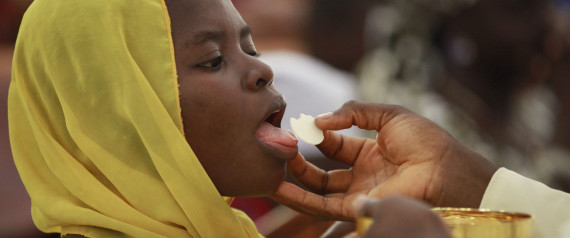The Holy Eucharist (also known as Holy Communion) was instituted by our Lord Jesus Christ Himself. Our Lord made it clear at the Last Supper that this was not to be an optional nor occasional observance. By using these words "DO THIS", He sets forth a command, not a request. This command is to be obeyed by all Christians until His coming again.
read more


2 comments:
“Moses did not give you the bread from heaven, but my Father give you the true bread from heaven” (6:32).
Jesus is the bread that is much better than manna or any physical food which can only sustain physical life for a short time. He gives eternal life. “He who comes to Me shall never hunger, and He who believes in Me shall never thirst...Most assuredly, I say to you, he who believes in Me has everlasting life” (6:35, 47).
Jesus reminded them that those who ate manna eventually died; He promised that those who eat of the living bread of heaven would live forever. It is in this sense Jesus’ flesh is real food and His blood real drink.
He is real food because He gives eternal life. “This is the bread which came down from heaven – not as your fathers ate the manna, and are dead. He who eats this bread will life forever” (6:58).
Rebutting Catholic Arguments - with a little help from Augustine
Was Jesus speaking figuratively?
a. Catholic apologists assert that Jesus was speaking literally when He spoke of eating His flesh and drinking His blood. This is evidently not so. Jesus was using figurative language as He usually did. In John’s Gospel, Jesus referred to His body as the temple (2:19); He called Himself the Light of the world (8:12), and we are called to follow Him; He is “the door” (10:9) through whom we enter for salvation; He is the “good shepherd” (10:11) and “the true vine” (15:1) and the disciples are compared to sheep and branches. That Jesus is the bread of life and that we should feed on Him is but a similar figurative expression illustrating the great spiritual truth that Jesus is the Divine Messiah who gives eternal life to all who believe.
b. Catholic apologist presents this argument: “The Greek word he used for ‘eats’ (tragon) is very blunt and has the sense of ‘chewing’ and ‘gnawing.’ This is not the language of metaphor.” Well, why not? Metaphors are intended to be graphic and impressive. Trogo stresses the slow process of eating. In the New Testament it is also used for ordinary eating (see Matthew 24:38; John 13:18; etc). Moreover, Jesus also uses the ordinary word for eating (phago) in the same passage (verses 50,51,53 etc). Since the two terms are used to make the same point – e.g. compare verse 53 (phago) and verse 54 (trogo) – they are practically equivalent.
c. In his discussion on the interpretation of figurative expressions, Augustine uses “eating flesh and drinking blood” as a typical example of a metaphor! He explains: “If the sentence is one of command, either forbidding a crime or vice, or enjoining an act of prudence or benevolence, it is not figurative. If, however, it seems to enjoin a crime or vice, or to forbid an act of prudence or benevolence, it is figurative. "Except ye eat the flesh of the Son of man," says Christ, "and drink His blood, ye have no life in you." This seems to enjoin a crime or a vice; it is therefore a figure, enjoining that we should have a share in the sufferings of our Lord, and that we should retain a sweet and profitable memory of the fact that His flesh was wounded and crucified for us” (Augustine, On Christian Doctrine, III).
Post a Comment